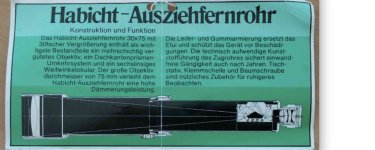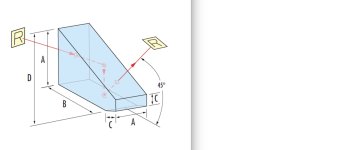In relation to Swarovski's offerings . . .
Draw Tube Telescopes
As Henry indicates, the first series of AZF draw tube telescopes used Abbe-Koenig prisms.
The 30x75 version was introduced in 1967, and the 25-40x75 followed in 1983. They remained in production until 1992.
There were both standard and short versions of each. The short S versions were introduced in 1982 and 1983,
and used a 3 element objective (in a 2, 1 configuration), as opposed to the conventional 2 element cemented objective.
(The same distinction as with the original short/ CF and later standard/ IF versions of the DT binocular telescopes of 1982 and 1989.)
For each of the four, there were also near focus NZ versions via a 2 position switch. They were variously introduced in the early to late 1980’s.
(On the regular versions the closest focus distance was 20 m verses 8 m on the NZ ones.)
a) See the optics of a standard 30x75 model from an early guarantee leaflet
(and although not particularly clear, it has the same 6 element eyepiece as in the S NZ version below):

b) And for comparison, the optics of the 30x75 S NZ version are shown in an image from Henry, in post #6 at:
New compact Zeiss Dialyt scope
(in addition to the third lens at the front of the objective, there's also a doublet in front of the prisms).
- - - -
In 1993, Swarovski introduced a new C series of draw tube telescopes using Schmidt-Pechan prisms
(C because the S-P prisms are compact compared to the A-K ones?)
See the optics of the current CTC 30x75 in post #3 at:
CTC 30x75 question?
(the eyepiece also differs significantly from the AZF version).
Fixed Body Telescopes
Early fixed tube models from Swarovski (and Zeiss and Leica) used Porro prisms.
And as Henry indicates in post #2, the angled body versions needed an extra prism for the 45 degree offset.
In contrast with roof prism models, a single triangular Schmidt prism can provide a 45 degree offset,
while a straight body requires a Schmidt-Pechan prism pair.
The Swarovski AT and ST Porro prism models were introduced in 1990. And the ATS and STS roof prism models replaced them in 2002.
The optics of various Swarovski Porro and Schmidt prism models can be seen in post #9 at:
Need Info about Swarovski ATM 65
• To help make sense of the Porro prism AT in the first image, see a half penta prism from:
Half-Penta Prisms | Edmund Optics

• With the ATM in the fourth image, the bottom surface of the Schmidt prism is roofed (there are 2 intersecting surfaces), so there is a total of 4 reflections
i.e. at the roof the light column is split in two, with each half of the column reflecting off one surface and then the other, and then recombining.
- - - -
And interestingly in 2014, Swarovski reverted to the use of Porro prisms on the STR model.
This was to enable the inclusion of an electronically projected reticle, see the detailed images at:
STR Telescope - Reticle System
John













